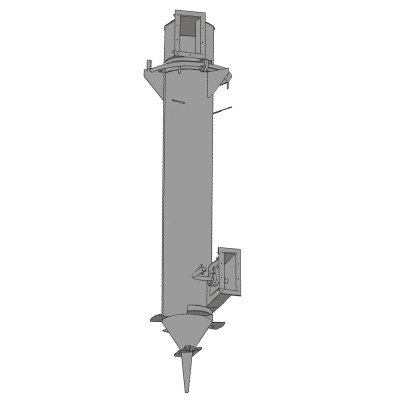Scrubbers of the Central Gas System
Scrubbers are devices of various designs for washing contaminated gases with liquids in order to remove one or more components from them. Centrifugal scrubbers of class CS are dust collection units designed to clean the air from dust contaminations formed during the transportation and processing of coke, quartz sand, coal, abrasives, limestone, various types of ores, etc.
Marking of the scrubber of class CS
"CS - 7", where:
- "CS" - centrifugal scrubber;
- "7" - the number corresponding to the internal diameter of the scrubber of 700 mm.
Design advantages
The centrifugal scrubber of class CS is a hollow, vertically mounted cylinder. The inlet pipe for the contaminated gas is located in the lower part of the cylinder. In the upper zone around the circumference of the cylinder there are nozzles through which the liquid enters the inner surface of the cylinder to create a thin water film. The performance of CS class scrubber models varies from 1000 to 10000 m3/h, the cylinder diameter is 300 ÷ 800 millimeters, the height is 2355 ÷ 5715 millimeters, the mass is 80 ÷ 407 kilograms, the hydraulic resistance is 400 ÷ 850 Pa. The recommended speed of entry of the contaminated flow into these scrubbers is 15-23 m/s.
For optimal operation of the scrubber, the water pressure in front of the nozzles should be constant and equal to 0.2 atm, which is ensured by installing an intermediate water tank (ball valve). Depending on the density, dispersion of contaminants, the speed of supply of clogged air and the diameter of the cylindrical section of the scrubber, the efficiency of cleaning dusty air reaches 86% - 90%. It becomes higher with increasing dust density, supply speed, and decreasing the diameter of the cylindrical section. The level of cleaning for particles larger than 30 microns is 90%, for particles closer to five microns it decreases to 80%, for particles smaller than five microns it is 40%.
Operating principle
The centrifugal scrubber of the CS class is a cylinder housing, the lower zone of which receives contaminated air through the inlet pipe. In the upper zone of the housing, nozzles are installed for supplying water, which creates the thinnest water film that flows down the walls of the housing. The flow of contaminated air in the scrubber cavity makes helical movements, rising to the upper zone. Due to the appearance of centrifugal force, dust particles are pressed against the walls of the unit. The displaced wet dust under the action of gravity together with water rolls down to the lower zone of the structure, forming pulp. It is removed from the unit using a drain pipe, which is closed at the right moment by a special valve. The cooled, humidified, purified air medium leaves the boundaries of the scrubber design without hindrance.
Advantages
- high dust collection efficiency;
- the possibility of simultaneously cleaning the gas stream from suspended solid particles (dust collection), cooling the gas media being purified (heat exchange);
- relatively low price.
Field of application
Centrifugal scrubbers of the CS class are widely used in the capture of coking products, the purification of industrial gas mixtures from dust, for cooling and humidifying gas media in chemical and technological processes of various kinds. Centrifugal scrubbers of class CS are in demand in exhaust ventilation systems for cleaning air contaminated with dust generated during transportation, as well as processing of limestone, quartz sand, abrasive materials, coal, various ores, coke, etc.
Class CS scrubbers are used:
- first stage of cleaning:
- exhaust ventilation systems from crushing and sorting equipment - elevators, crushers, transfer units, etc.;
- exhaust ventilation systems from knockout grids in foundries, land preparation equipment;
- second stage of cleaning:
- exhaust systems with high initial concentrations of contaminants - suction units from sandblasting booths and chambers.
Installation and operation features
The CS class scrubber is recommended to be installed before the fan (on the suction side) in order to protect it from wear, while the water is drained from the lower zone of the fan casing. The air exhaust from this unit is carried out:
- upwards, bypassing the shaft or to the side through a snail - installation of the scrubber after the fan;
- through a snail - installation of the scrubber to the fan.



















